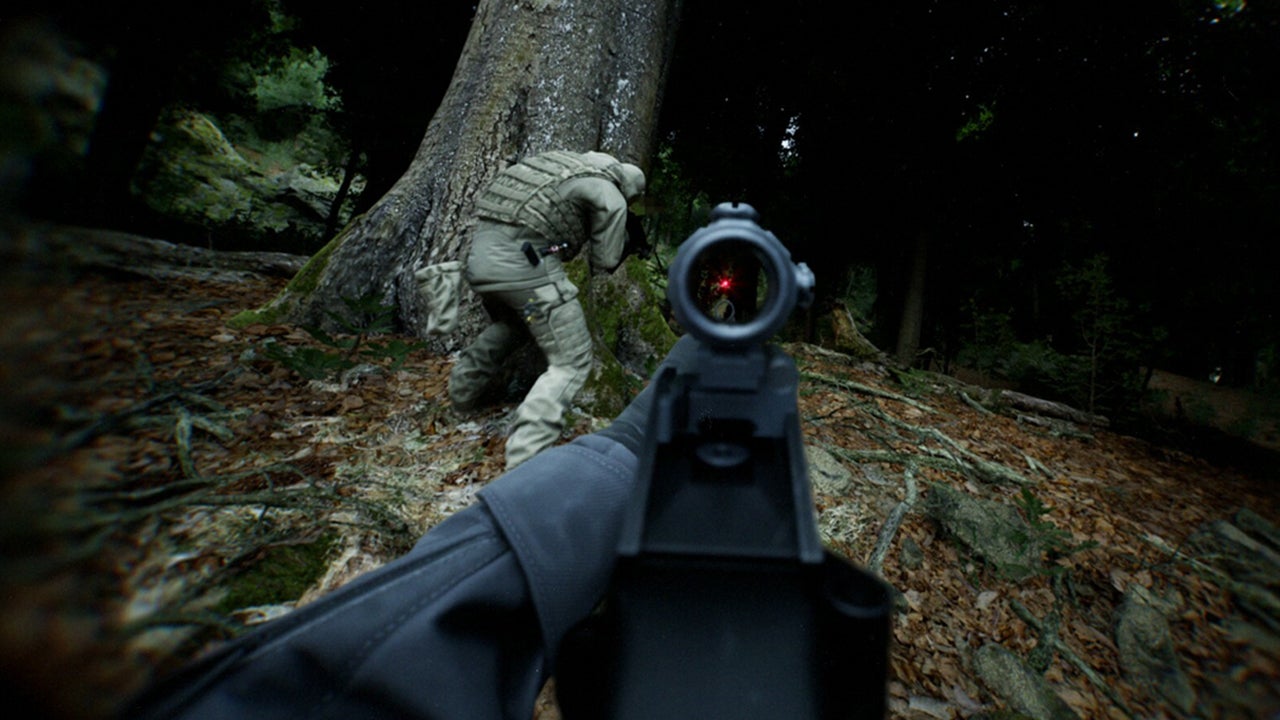There is a concept in business called “fast following”. The idea is basically that one company shows off a product it’s working on, and another imitates it and releases its version quickly, capitalizing on the hype and beating the original to market. Bodycam, made by the two-man team at Reissad Studio, looks a lot like the quick follow-up to Unrecord, a first-person shooter from the perspective of a police bodycam that attracted a lot of attention for its extremely realistic graphics. This isn’t necessarily a bad thing – Fortnite, for example, adding a PUBG-like battle royale literally changed the game. Unfortunately, this is not the case with Bodycam. While it’s an interesting proof of concept in early access, it has too many critical design blind spots to be a good shooter just yet.
The idea behind the Bodycam is creative and the combination of the rounded lens, dust on the glass and rough movement does a good job of selling the atmosphere of real police style footage. It pairs well with high-quality textures, dense debris, and lush greenery to make for a visually impressive game. The lighting effects in particular are excellent, with a wide range from pitch-black corridors to blindingly bright flashlights playing an important role in strategy in the team-based modes.
Unfortunately, the concept just isn’t great for a competitive first-person shooter, because you don’t gain anything by having a worse view of the world. This makes finding and shooting enemies more awkward and doesn’t add thematically to the experience. The police don’t look through a camera when they’re actually involved in a shootout, and since you’re not actually playing as law enforcement, it doesn’t say anything about the state of the police. It’s also a bit odd how aiming at the site means your character raises the gun to their chest to be in front of the camera rather than in front of their eyes. I can see how this perspective would work great for something like a horror game; the time spent lurking in the dark and deciding if and when to risk giving away my position by turning on my flashlight to see is quite fascinating. Here, though, it feels deceptive rather than immersive.
However, the basic shooting mechanics are solid. Bodycam is a classic example of pixel shooting: as soon as you see an open pixel of the enemy, you open fire, hoping to defeat him to the end. It only takes one well-aimed bullet to kill or be killed, and even a handful of less accurate hits are enough to send you to an early grave. I like that it creates opportunities to win engagements through smart positioning and anticipation rather than brute marksmanship, and it’s especially important to carefully duck around corners rather than run and shoot. Ultimately, whether or not you’re a fan of instant kills is a matter of taste, but just know that this isn’t a shooter that allows for a margin of error.
Some skill is required to compensate for the fact that the weapons tend to have a lot of recoil, which makes accuracy difficult if you’re leaning on automatic fire. It’s a realistic element that makes taking down other players in quick succession especially satisfying.
I just wish the traffic was better. I’m sure some of this has to do with the disjointed way characters’ arms and bodies move independently of the bodycam itself, but it’s all too easy to get stuck on small obstacles that clutter the hallways, like desks and filing cabinets. With how slow and deliberate the characters move and how fast the time to kill is, being stopped because your elbow hits a table is both annoying and potentially deadly. In theory, you can climb over small obstacles, but in practice, even the smallest step up can be a big obstacle to your character’s passage, and every second you spend exposes you to deadly gunfire.
That’s a shame, because the six levels in Bodycam are pretty neat right now. An abandoned hospital, for example, has a great mix of long corridors and connected offices. The Russian building level is also spooky as hell when the built-in day/night cycle decides it’s time for the sun to set. Another is an airsoft arena complete with a plywood mock-up of a house and human-shaped training dummies that I must have shot in a moment of panic when they surprised me coming around the corner. The way each level looks and plays differently is effective at preventing the “been there, done that” feeling after playing the limited selection of three game modes, at least for a while.
Not race ready
Team deathmatch is my favorite way to play Bodycam. Up to 10 players are divided into teams and given the same weapons, but this equipment is randomly distributed after each round and the first to 10 wins. Maybe you all have pistols one time, but rifles another time. It’s a unique spin on a tried-and-true shooter, and having each round be elimination-based with no respawning raises the tension considerably. The moments where I carefully sneak down corridors, sharing the responsibility of checking corners with a teammate, do a great job of scratching that tactical itch.
When you die, you respawn as a drone until the end of the round, giving you the opportunity to either watch things play out or scout the other team’s positions. It’s pretty fun to turn on your drone’s flashlight and spot the enemy, doing your best to avoid being shot down by annoyed opponents.
Standard deathmatch is unfortunately a bit of a disaster. Respawns are fast and it’s all about racking up kills, which completely removes the tense tactical action from the equation. Even worse, the spawns are horribly managed. Every time you die, it’s basically a roll of the dice whether your next life starts with looking down the barrel of a gun, and it’s common to go several lives without time to make a move before you’re gunned down. It’s in dire need of a major overhaul, and being the only solo mode, Bodycam doesn’t have much to offer anyone who prefers to go it alone.
Meanwhile, Bodybomb has one team trying to plant and defend a bomb, somewhat similar to Counter-Strike or Search and Destroy from Call of Duty. The biggest difference here is that the bomb can be placed anywhere, but the duration of the detonation timer decreases the further into enemy territory you choose to place it. It’s a good concept, but it doesn’t work very well in practice. The main problem is that it’s too easy for the bomb squad to just arm themselves right away and then just set up a camp to guard all the roads leading to it. In my experience, it’s rare for the bomb team to not score when this happens, which saps all the competitive energy out of the match.
The other problem—one that’s universal to all modes—is that they just take too long. A match can easily last 30 minutes, which feels like an eternity in a small team shooter like this. There have been many times where I would have been happy to just pop in for a quick match before doing anything else, but the time required just won’t allow it. Even worse, since it uses peer-to-peer connections instead of servers, if the host leaves or disconnects at any point – no matter how far along the game is – the match is over. This is unfortunately all too common, especially when the home team is on the losing side of the match.
Assuming you can complete your match, your rank will go up or down in a simple leaderboard system that gives you something to aim for. It works as expected, except in Deathmatch, where only one person wins – you can end up with a very strong kill-to-death ratio that puts you in second place, and still drop down the ranks. Giving positive progression to the first few finishers is quite common in other shooters and seems like an odd omission here.
The other thing you can advance is your cosmetics. Match performance (such as kills) and victories earn you R Points, which you can spend on one of 11 cosmetic items for sale. That’s a total of 11 beauty products available at any given time, not 11 categories. You can buy the shirt for sale or the single hat option. Hopefully the store will expand with future updates, but I can’t help but wonder what the point of having a store at all is if there is so little to choose from. It’s refreshed daily, but things are so expensive that it’s easy for more interesting options, like a unique gas mask, to get shuffled before you can save up for it. The 4000 R it would take to buy a backpack, for example, represents several hours of grinding. There’s text in the menu that says you can pay for R points to save time, but that’s not actually true; at the time of writing, there is no mechanism to buy points, you just earn them in-game, which adds to the feeling that the store just isn’t ready, even for early access.



